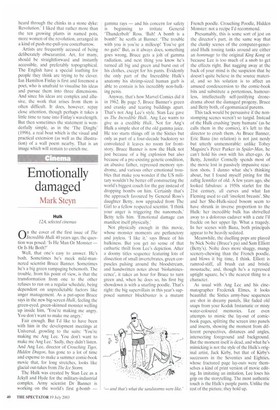Pastoral musings
Andrew Lamb irth
Ian Hamilton Finlay: Idylls and Interventions Victoria Miro Gallery; 16 Wharf Road, London Ni until 2 August
The artist Ian Hamilton Finlay (born 1925) is a poet, philosopher and gardener. Since 1966 he has lived at Stonypath in Lanarkshire, in the Southern Uplands of Scotland, where he has created a remarkable garden out of the wilderness. This he named Little Sparta in 1978, inaugurating a 'Five Year Hellenization Plan'. The garden is a statement of belief, containing many of his sculptures and tablets inscribed with his observations about life, revolution and idealism. A man of decided opinions and no stranger to controversy, Finlay has famously described Little Sparta as not so much a retreat as an attack.
Finlay is Britain's foremost concrete poet, and works in close collaboration with a host of craftsmen and other artists to make the various objects and publications which represent his surprisingly diverse artistic output. The current exhibition in Victoria Miro's vast warehouse gallery is a complex installation of sculpture and furniture, wild flowers and texts, silkscreen prints, stone carving and wood carving, and a full-size, clinker-built, copper-fastened sailing dinghy from the Isle of Wight. Finlay examines once again his favourite themes, regrouping his familiar motifs, and deploys them with slight but telling variations. A metal watering-can is painted turquoise and placed atop a fluted column. In scarlet capitals on its side runs the legend: 'Revolutions dethrone Kings and enthrone columns and watering-cans.' Is Finlay simply being fey? (Actually, the object is witty and visually arresting.) For a start, it is important to remember that the watering-can has to be fully functional and able to serve its original purpose, and secondly it is germane to recall that the Robespierrists were guillotined on the day the Republican Calendar called 'Wateringcan' (Arrosoir). Here are two of Finlay's central preoccupations: husbandry and the French Revolution. The garden may be served but so must history.
But what is Finlay's meaning? There is a sense of the inscrutable about his work. His pastoral musings seem to imply a yearning for the simplicity of some mythical golden age, his classicism is all in the poetic gesture. His taste for the epigrammatic is formidable. Several of the exhibits are ceramic wildflower jars, emblazoned with phrases. For instance: 'A wild flower is the realisation of a concept, a garden flower of an effect.' Or: 'A wild flower is ideological, like a badge.' Or again: 'Virgil discovered the evening. Rousseau picked the first wild flower.' There is a magic to this kind of incantation, a strange beauty. Finlay offers a statement, not enlightenment. So: 'We understand the wild flower ethically, the garden flower aesthetically.' Enough perhaps that we should be provoked to thought or to a smile.
The cut wild flowers are daily replenished by the gallery staff, who seem to enjoy this participation. The mixture of practical and high-flown continues. Lithographically reproduced Suffolk Herbs seed packets are arranged in an inflammatory slogan: 'Revolution, virtue, eloquence, transparency.' A cherry-wood table is laid with 12 place settings for Les Femmes de la Revolution, a name on each plate. (A lot of Finlay's work is about the power of naming.) Down the other side of the gallery is arranged a row of 12 wooden stools, each with a ceramic candlestick placed upon it. The women are plates, and the men are the rather more obviously phallic candlesticks. Each is named Saint-Just, for instance, or Robespierre. Saint-Just, who was known by his contemporaries as the Archangel of the Terror, is one of Finlay's heroes, and a quote from his writings — he was a poet as well as a politician — appears as the motto in a sandstone carving upstairs. Diversifying the theme, 'Apollo/Saint-Just' is a set of four bronzes of the god/politician bearing modern arms.
The installation continues on the first floor with three wooden panels shaped like guillotine blades (or could they be sails?) hung high on the wall with the title 'Liberty Equality Fraternity'. 'Classical/ Neo-Classical' is a red sandstone sculpture of two segmented columns, the first and classical one decorated with a tongue-like leaf pattern, the neoclassical being a leaning tower of snare drums. How heavy is the irony? A concrete poem is stencilled on the wall. The sound of running water heard through the chinks in a stone dyke: Revolution. I liked that rather more than the ten growing plants in named pots, more women of the revolution, arranged in a kind of push-me-pull-you costerb arrow.
Artists are frequently accused of being deliberately obscurantist. Art, for many, should be straightforward and instantly accessible, and preferably topographical. The English have a special loathing for people they think are trying to be clever. Ian Hamilton Finlay is first and foremost a poet, who is unafraid to visualise his ideas and pursue them into three dimensions. And since his ideas are complex and allusive, the work that arises from them is often difficult. It does, however, repay close attention, though perhaps it takes a little time to tune into Finlay's wavelength. But then sometimes the statement is wonderfully simple, as in the The Dinghy' (1996). a real boat which is the visual and practical extension (as well as the illustration) of a wall poem nearby. That is an image which will remain to enrich me.



























































 Previous page
Previous page